 |
Roasting Turkey - Cooking Tips | ||||||||||||||||||||||||||||||||||||||
| view article online: https://www.recipetips.com/kitchen-tips/t--412/roasting-turkey.asp | ||||||||||||||||||||||||||||||||||||||
Procedure for Roasting a Turkey | Roasting Time Guidelines | Roasting a Turkey in an Oven-Safe Roasting Bag Roasting is a dry heat cooking process and is one of the most popular methods used for cooking turkey. The roasting process tends to evaporate and reduce the moisture content of any type of meat, shrinking the fibers and making the meat tough, so it is important to follow the proper steps for roasting to ensure the best results. When roasted properly, turkey meat is moist and tender with excellent flavor. Procedure for Roasting a Turkey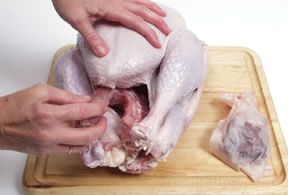
In order to prepare the turkey for roasting, the neck and giblets, which are usually placed inside the body cavity when the turkey is processed, must be removed. 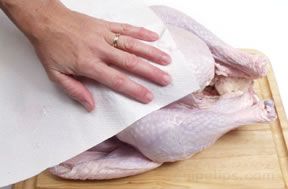
Rinse the turkey inside and out with cold water and pat the surface dry with paper towels. 
The turkey can be seasoned with salt and pepper and with any herbs and spices that are desired, but this is optional. If the turkey is to be stuffed, the stuffing should be inserted into the body cavity immediately before the bird will be placed in the oven. Do not stuff the bird far in advance with the idea that this will save time when it is time to roast the turkey. Stuffing that remains inside an uncooked turkey for lengthy periods may promote the rapid growth of harmful bacteria prior to cooking. It is also important that the turkey not be overstuffed because the stuffing will expand as it cooks. 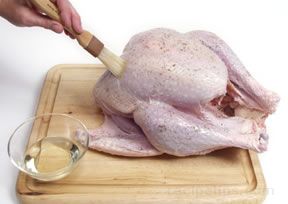
The turkey may be coated with oil or butter to help brown the skin, but this is optional. 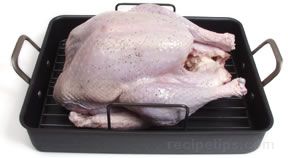
Place the turkey breast side up on a cooking rack in a shallow roasting pan and place the pan in the center of the lowest rack of a preheated oven. Roast the turkey uncovered at a temperature ranging from 325°F to 350°F. Higher temperatures may cause the meat to dry out, but this is preferable to temperatures that are too low which may not allow the interior of the turkey to cook to a safe temperature. Some cooks prefer to roast the turkey at temperatures as high as 450°F to 500°F for the first 30 minutes in order to brown the surface. The heat is then reduce to 325°F for the remainder of the cooking time. It is important to keep the oven door closed as much as possible while the turkey is roasting to maintain a constant temperature within the oven. 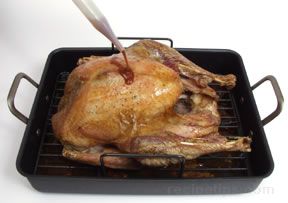
Basting a turkey provides a crispy, golden skin, but it does not add moisture or flavor to the interior of the turkey. Basting should be kept to a minimum so that the oven door is not opened too often. The more times the oven door is opened, the longer the cooking time will be because of heat loss within the oven. 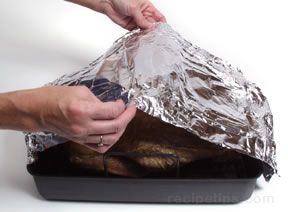
Aluminum foil can be tented over the turkey near the end of the cooking time to keep the skin from becoming too brown. 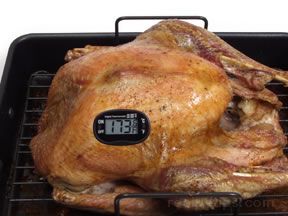
Use a meat thermometer to determine the proper doneness, which is at least 170°F for the breast and 180°F for the thigh. After removing the turkey from the oven, the temperature of the meat will increase by about 5° as the turkey rests. It is important that the turkey is not overcooked, because the breast meat may dry out quickly. 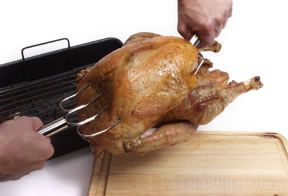
After the turkey is removed from the oven and before the turkey is carved, allow it to rest at least 20 minutes so that the juices settle within the meat, which provides the meat with more flavor and tenderness and will also make carving much easier. More or less time may be allotted depending on the size of the turkey. Large lifting forks, such as those shown in the picture at the right, should be used to remove the turkey from the roasting pan. 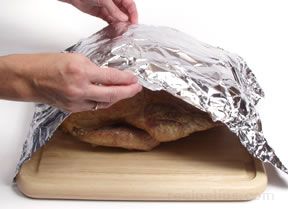
After the turkey is placed on a large, clean cutting board, it should be tented with aluminum foil to retain heat while it is resting. Note: A disposable aluminum pan is not recommended for roasting a whole turkey. The weight of the turkey may cause the pan to buckle when it is removed from the oven, creating a dangerous situation. Roasting Time GuidelinesRoasting times may vary greatly, depending on a number of variables that affect the cooking time such as the shape of the turkey; the proportion of meat to bone; the variations of different ovens; the altitude; and whether the turkey is fresh, or frozen and then thawed. Adding to the confusion is that almost every source providing roasting time charts is different from one another. Shown below is another such chart, which should be used as a general guideline only. Remember, the only true gauge for determining proper doneness is with a meat thermometer. The breast must reach an internal temperature of 170°F and the thigh must reach an internal temperature of 180°F.
Note: Using a convection oven will cut as much as 25% off the cooking times list above. Variables that can Affect the Roasting Time of a Whole Turkey
Roasting a Turkey in an Oven-Safe Roasting Bag
An oven-safe bag may be used for roasting a turkey. The oven roasting bag keeps the turkey very moist and decreases the roasting time. The preparation and roasting steps are identical to the steps used for preparing and roasting a turkey without an oven bag except for the following additional steps:
The following cooking times can be used as a guideline for roasting an unstuffed turkey in an oven bag in a conventional oven at 350°F.
Add 30 minutes or more to the times listed above when roasting a stuffed turkey; however, this is only a rough estimate. Remember, the only reliable gauge for determining proper doneness is with a meat thermometer. The breast meat must reach an internal temperature of 170°F and the thigh must reach an internal temperature of 180°F. The stuffing must reach a temperature of at least 165ºF. | ||||||||||||||||||||||||||||||||||||||
| Copyright 1999-2024 - Tecstra Systems Corporation/RecipeTips.com - All Rights Reserved | ||||||||||||||||||||||||||||||||||||||